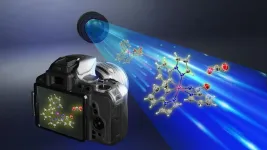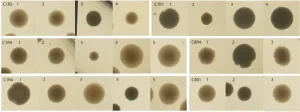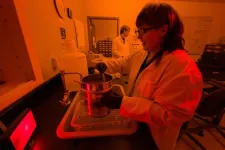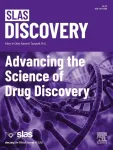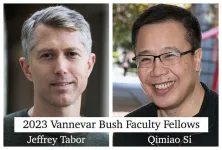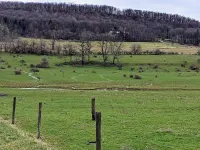(Press-News.org)
NEW YORK, NY--Perhaps the most profound advance in primate evolution occurred about 6 million years ago when our ancestors started walking on two legs. The gradual shift to bipedal locomotion is thought to have made primates more adaptable to diverse environments and freed their hands to make use of tools, which in turn accelerated cognitive development. With those changes, the stage was set for modern humans.
The genetic changes that made possible the transition from knuckle-based scampering in great apes to upright walking in humans have now been uncovered in a new study by researchers at Columbia University and the University of Texas.
Using a combination of deep learning (a form of artificial intelligence) and genome-wide association studies, the researchers have created the first map of the genomic regions responsible for skeletal changes in primates that led to upright walking. The map reveals that genes that underlie the anatomical transitions observed in the fossil record were strongly acted on by natural selection and gave early humans an evolutionary advantage.
“On a more practical level, we’ve also identified genetic variants and skeletal features that are associated with hip, knee, and back arthritis, the leading causes of adult disability in the United States,” says Tarjinder Singh, PhD, assistant professor of computational and statistical genomics (in psychiatry) at the Columbia University Vagelos College of Physicians and Surgeons and a co-leader of the study.
For example, slight deviations from the average hip width-to-height ratio were associated with an increased risk of hip osteoarthritis, while slight deviations in the tibia-femur angle were associated with an increased risk of knee osteoarthritis. These insights could help researchers devise new ways to prevent and treat these debilitating conditions.
The findings were published July 21 in Science. The study was co-led by Vagheesh M. Narasimhan, PhD, assistant professor of integrative biology and of statistics and data sciences at the University of Texas at Austin.
New techniques deployed
The researchers applied deep learning to analyze more than 30,000 full-body X-rays from the UK Biobank. Deep learning, a technology modeled after the brain’s neural networks, trains computers to do what comes naturally to humans, such as driving a car or translating languages. In this case, the technique was used to standardize the X-rays, remove any images with quality issues, and then precisely measure dozens of skeletal features, tasks that would have taken the researchers months, if not years, to complete.
Next, the researchers scanned the human genome to identify chromosomal regions associated with variations in 23 key skeletal measures, such as shoulder width, torso length, and tibia-to-femur angle. (These scans, called genome-wide association studies, involve surveying the genomes of large groups of people, looking for genomic variants that occur more frequently in those with a specific disease or trait compared to those without the disease or trait.) This process revealed 145 regions associated with genes that regulate skeletal development. Only a handful of these loci were known from previous studies.
Many of the 145 regions overlapped with “accelerated” regions of the human genome, which have rapidly evolved over eons compared with the same regions in great apes. In contrast, few genes associated with the heart, immune system, metabolism, and other traits were found in accelerated regions.
“What we’re seeing is the first genomic evidence that there was selective pressure on genetic variants that affect skeletal proportions, enabling a transition from knuckle-based walking to bipedalism,” says Narasimhan.
The study also shows the power of combining large-scale biobank data, machine learning, and genomics to help us understand human health and disease. Singh, who joined Columbia in 2022, is now applying these techniques to understand the causes of mental illness.
More information
Tarjinder Singh, PhD, is also an associate member of the New York Genome Center.
The paper is titled “The genetic architecture and evolution of the human skeletal form.”
The other contributors are Eucharist Kun (University of Texas at Austin), Emily M. Javan (Texas), Olivia Smith (Texas), Faris Gulamali (Icahn School of Medicine at Mount Sinai, New York), Javier de la Fuente (Texas), Brianna I. Flynn (Texas), Kushal Vajrala (Texas), Zoe Trutner (Texas), Prakash Jayakumar (Texas), Elliot M. Tucker-Drob (Texas), and Mashaal Sohail (Universidad Nacional Autónoma de México, Cuernavaca).
The study was supported by the Allen Discovery Center program and a Good Systems for Ethical AI grant from the University of Texas at Austin.
The authors declare no competing interests.
###
Columbia University Irving Medical Center (CUIMC) is a clinical, research, and educational campus located in New York City. Founded in 1928, CUIMC was one of the first academic medical centers established in the United States of America. CUIMC is home to four professional colleges and schools that provide global leadership in scientific research, health and medical education, and patient care including the Vagelos College of Physicians and Surgeons, the Mailman School of Public Health, the College of Dental Medicine, the School of Nursing. For more information, please visit cuimc.columbia.edu.
END
Led by Director CHANG Sukbok, scientists from the Center for Catalytic Hydrocarbon Functionalizations within the Institute for Basic Science (IBS) have made a breakthrough in understanding the structure and reactivity of a key intermediate in catalytic reactions. This intermediate, known as a transition metal-nitrenoid, plays a crucial role in converting hydrocarbons into amides, which are important in pharmaceuticals and materials science.
In chemical reactions, intermediates are substances that are formed and consumed during the transformation of reactants into products. Hence, understanding these intermediates ...
Microbial communities are widely used biotechnology suppliers for processes like manufacturing biofuels and new foods, or helping crops grow better. To engineer successful communities, scientists need to predict whether microorganisms can live and work together. One popular predictive rule states that if a pair of microbes will coexist, they will also coexist in a bigger community of microbes. A study published in Science now found that this simple rule will not always work.
Just like plants and animals, microorganisms live in complex ecological communities consisting of multiple species that ...
LOGAN, UTAH, USA -- New analysis of samples collected from underneath Greenland’s ice sheet reveal the Arctic island was much greener as recently as 416,000 years ago. The findings overturn previous views that Greenland’s continental glacier, which covers about 80 percent of the 836,3000-square-mile land mass, has persisted for the last two and a half million years.
“We’re discovering the ice sheet is much more sensitive to climate change than we previously thought,” says Utah State University geoscientist ...
Oak Brook, IL – The July 2023 issue of SLAS Discovery, the open access journal focused on research progressing drug discovery, is now available. Volume 28, Issue 5, contains one short communication and four full-length articles covering assay quality metrics, fluorescence resonance energy transfer (FRET) and small molecule glycomimetics and other high-throughput screening-related research.
Full-length articles
Mathematical relationships between control group variability and assay quality metrics
Authored by early ...
The world's computing needs have grown exponentially in recent years due to an explosion of technology. To meet the needs for the next technological leap, the scientific community is working to improve current processing capabilities and simultaneously develop entirely new computing methods.
Two new papers from the research group of Jean Anne Incorvia, a professor in the Cockrell School of Engineering’s Chandra Family of Electrical and Computer Engineering, aim to contribute to both of these scientific needs. Together, they offer improvements ...
A new study published in Gastroenterology aims to improve the effectiveness of screening and surveillance practices for early cancer detection in Barrett’s esophagus (BE).
BE is the only identifiable precursor lesion for esophageal adenocarcinoma (EAC), a lethal cancer with increased incidence and mortality rates over the last several decades.
The research, led by faculty at the University of Colorado (CU) Cancer Center, analyzed a large international database of over 20,000 newly diagnosed BE patients in Nordic countries to provide a more accurate look at how many patients have normal ...
The Damon Runyon Cancer Research Foundation has named six new Damon Runyon Clinical Investigators. The recipients of this prestigious award are outstanding, early-career physician-scientists conducting patient-oriented cancer research at major research centers under the mentorship of the nation's leading scientists and clinicians.
The Clinical Investigator Award program was designed to increase the number of physicians capable of moving seamlessly between the laboratory and the patient’s ...
HOUSTON – (July 20, 2023) – Rice University professors Qimiao Si and Jeffrey Tabor, are recipients of prestigious Vannevar Bush Faculty Fellowships from the United States Department of Defense.
Si, a theoretical quantum physicist, and Tabor, a bioengineer and synthetic biologist, are among 10 members of the 2023 class of Bush fellows named by the department’s Basic Research Office.
The highly competitive, five-year fellowships are among the federal government’s most prestigious individual research honors. Bush fellowships are awarded annually and include $3 million to pursue ...
HOUSTON – (July 20, 2023) – Visible light is a mere fraction of the electromagnetic spectrum, and the manipulation of light waves at frequencies beyond human vision has enabled such technologies as cell phones and CT scans.
Rice University researchers have a plan for leveraging a previously unused portion of the spectrum.
“There is a notable gap in mid- and far-infrared light, roughly the frequencies of 5-15 terahertz and wavelengths ranging from 20-60 micrometers, for which ...
UNIVERSITY PARK, Pa. — At a time when Pennsylvania is actively working to achieve water-quality improvements to meet the state’s obligations for cleaning up the Chesapeake Bay, a multidisciplinary Penn State research team is studying whether agricultural pollution-prevention devices called riparian buffers are working properly.
Riparian buffers — areas adjacent to streams or wetlands that contain a combination of trees, shrubs and grasses — are managed differently from the surrounding landscape to provide conservation benefits. In agricultural areas, buffers intercept sediment, nutrients, pesticides and chemicals ...
